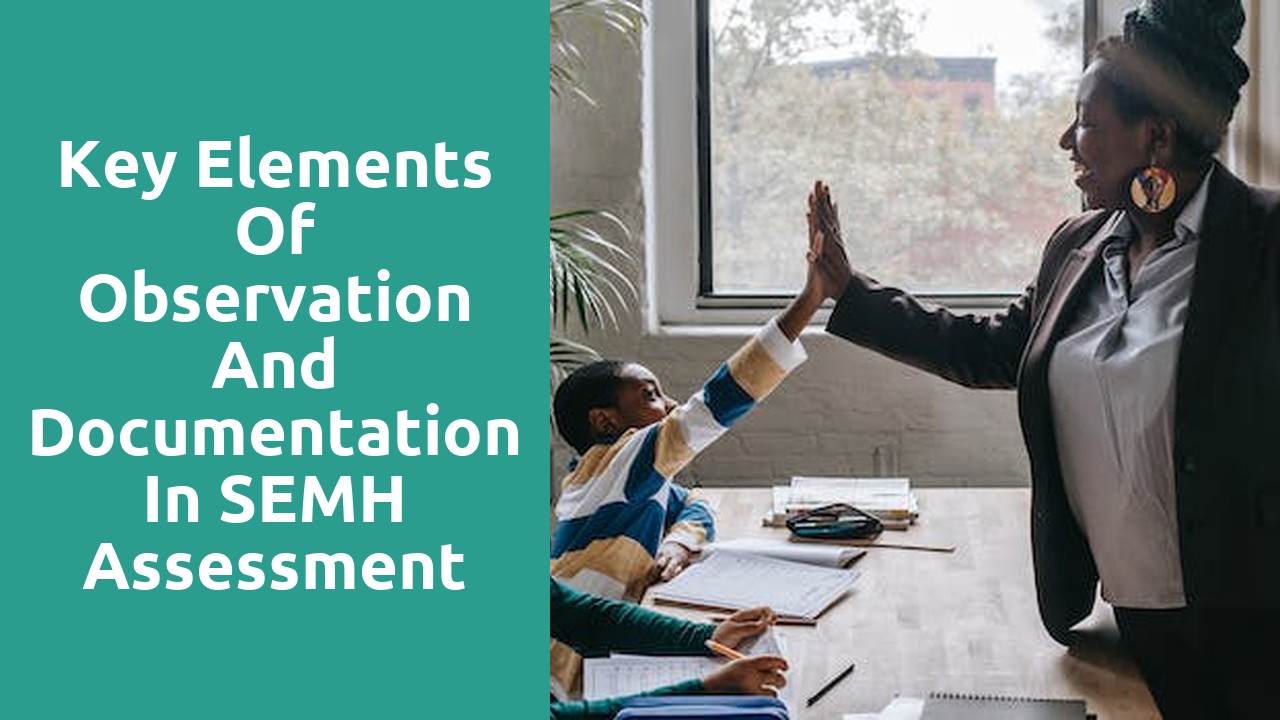

Observation and documentation play a crucial role in the assessment of Social, Emotional, and Mental Health (SEMH) disorders. By carefully observing individuals and their behaviors, practitioners can gain valuable insights into their overall well-being and identify any signs of SEMH difficulties. Through effective documentation, these observations can be accurately recorded and used to inform interventions and support strategies.
Effective observation involves attentively watching an individual's actions, expressions, and interactions with others. It requires a keen eye for detail and an ability to detect subtle cues and nonverbal communication. By observing individuals in various settings, such as classrooms, social settings, or therapeutic sessions, practitioners can gather comprehensive information about their emotional regulation, social skills, and mental health. This knowledge is then used to inform the assessment of SEMH difficulties and guide the development of personalized support plans.
Accurate SEMH assessment is crucial in understanding and supporting individuals with social, emotional, and mental health challenges. To ensure the accuracy of our assessments, it is essential to employ effective techniques that consider the unique needs and experiences of each individual. One technique that proves invaluable in this process is active listening. By actively listening to individuals, we can gain a deeper understanding of their thoughts, feelings, and experiences, enabling us to develop a comprehensive assessment that addresses their specific needs.
Another vital technique for accurate SEMH assessment is utilizing open-ended questions. Open-ended questions prompt individuals to provide detailed responses, allowing us to gather more comprehensive information about their experiences and challenges. These questions encourage individuals to delve deeper into their thoughts and emotions, providing us with valuable insights that can inform our assessments. Through open-ended questions, we can create a safe and non-judgmental space for individuals to openly share their experiences, providing us with the necessary information to develop accurate assessments.
Observational skills play a crucial role in enhancing our understanding of individuals with social, emotional, and mental health (SEMH) challenges. The ability to keenly observe and interpret behaviors, emotions, and interactions can provide invaluable insights into their experiences and needs. By honing our observational skills, we can develop a deeper understanding of the unique ways in which SEMH manifests in individuals, allowing for more accurate assessment and informed interventions.
One key aspect of enhancing observational skills in SEMH assessment is being mindful of nonverbal cues. While verbal communication is important, it is often limited in capturing the full range of emotions and experiences. Nonverbal cues, such as facial expressions, body language, and gestures, can offer additional layers of information. For example, a child who appears withdrawn during a group activity may be struggling with social anxiety, which might not be apparent through their verbal communication alone. By carefully observing these nonverbal cues, we can gain valuable insights and adapt our assessment strategies accordingly.
The process of documenting SEMH assessments requires careful consideration and attention to detail. One of the best practices in this art is to ensure that all relevant information is accurately recorded. This includes noting down any specific behaviors or symptoms that the individual displays, as well as any triggers or factors that may contribute to their emotional or mental health difficulties. By capturing these details, professionals can gain a deeper understanding of the individual's unique needs and tailor their intervention strategies accordingly.
Another crucial aspect of effective documentation is maintaining objectivity. It is essential to record observations and findings in a neutral and unbiased manner, avoiding any personal judgments or assumptions. This allows for a more accurate and comprehensive assessment, as it ensures that the information gathered is based solely on observable evidence. Additionally, professionals should strive to use clear and concise language when documenting their findings, ensuring that the information can be easily understood and interpreted by other team members involved in the assessment process.
Observation is a crucial component in the process of conducting SEMH assessments. By keenly observing a student's behavior, social interactions, and emotional responses, we gain valuable insights into their mental health and well-being. It is through careful observation that we are able to unravel the secrets of successful SEMH assessment.
When observing a student, it is important to adopt a non-judgmental and empathetic approach. This allows us to truly understand their experiences and emotions, without imposing our own biases or preconceived notions. By paying attention to the subtleties of their body language, facial expressions, and verbal cues, we can gain a deeper understanding of their unique challenges and needs. Effective observation provides us with a window into their world, helping us tailor personalized interventions and support strategies to aid their SEMH development.
Mastering the art of documentation in SEMH assessment plays a crucial role in ensuring accurate and effective evaluations. The ability to record observations and findings in a comprehensive manner enables professionals to provide a thorough analysis of a student's socio-emotional and mental health needs. Moreover, it facilitates better collaboration among educators, therapists, and parents, fostering a holistic approach towards supporting students with SEMH difficulties.
To master the craft of documentation, professionals must adhere to some best practices. First and foremost, it is essential to maintain objectivity and professionalism in the documentation process. This includes refraining from personal biases or judgments and focusing solely on the observable behaviors and emotional responses exhibited by the student. Additionally, using clear and concise language is pivotal to ensure clarity and understanding for all parties involved. A well-documented evaluation should be easily comprehensible and provide a comprehensive picture of the student's strengths, challenges, and specific areas requiring targeted interventions.